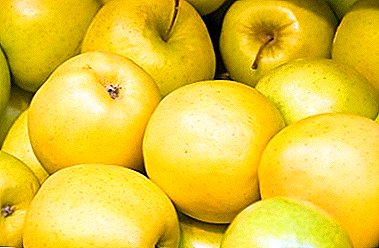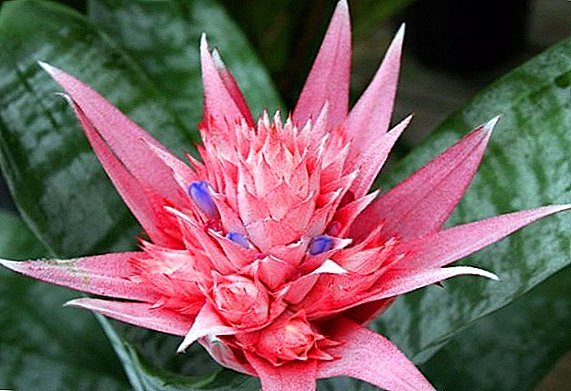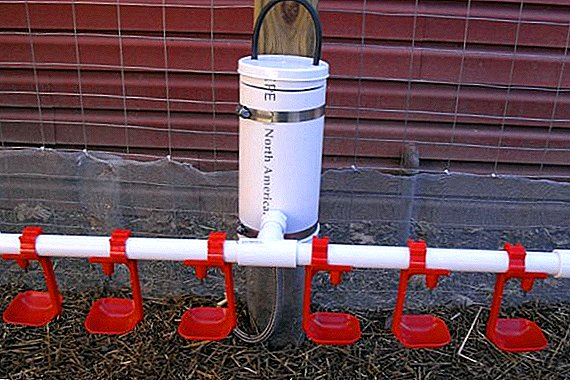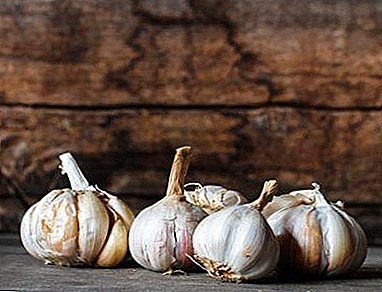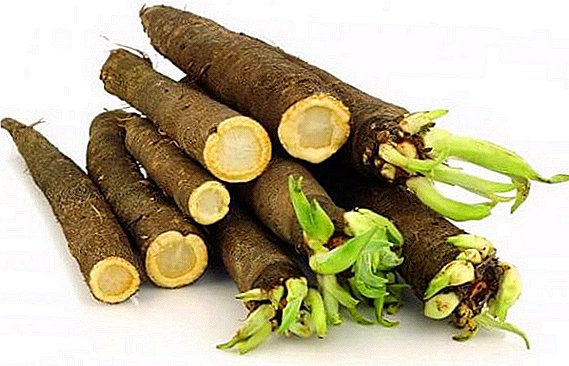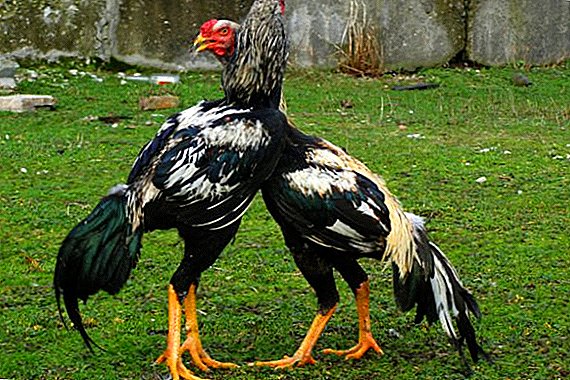 Coolangs are a rare breed of fighting chickens with a bad temper, low egg production and poor meat indicators.
Coolangs are a rare breed of fighting chickens with a bad temper, low egg production and poor meat indicators.
They are rarely found on farmsteads, because such animals are preferred only by fans of cock fighting. On the features of this species of birds, as well as the rules of its content, we will describe below.
The history of the breed
Today, few people know about aggressive kulangs, or, as they are also called, dakans. The breed has survived for many generations and is now on the verge of extinction. Ornithologists consider it one of the oldest chicken varieties originated in Asia.
Did you know? Small chickens demonstrate a set of skills and reflexes available to a three-year-old child. In general, chickens, despite the stereotype about the limited capabilities of their brains, can remember about a hundred people, recognize their owner and be well oriented in time.
The tradition of having fun and making money on cockfighting originated many centuries ago in the Khiva and Bukhara khanates, as well as in Uzbekistan, Kyrgyzstan and the southern regions of Kazakhstan. It was with this and was associated with a special interest in the cultivation of fighting breeds.  But not every rooster could take part in the competition. For centuries, the fighting ideal has been perfected. He had to have a strong constitution and body weight, and also to prevail on aggressiveness. The main qualities of the Dacan breed were formed by natural selection.
But not every rooster could take part in the competition. For centuries, the fighting ideal has been perfected. He had to have a strong constitution and body weight, and also to prevail on aggressiveness. The main qualities of the Dacan breed were formed by natural selection.
It is characteristic that even in some regions of Turkmenistan and Uzbekistan, isolated farms have been preserved, where, in order to preserve the genotype, they specialize exclusively in breeding this unique breed, the main features of which are non-standard appearance and special character. But now it is positioned as a sports decorative.
Did you know? In India, domesticated chickens for a long time was considered a cult animal, so their meat was strictly forbidden to eat. But the hunt for their wild relatives was welcomed.
Appearance of males and females
Kulangs are easy to learn. They differ from traditional meat-egg chicken breeds in the structure of the elongated body and low weight. But in fact, these chickens are not skinny, because they have a very muscular and dense body.  Chickens weigh about 3 kg, and roosters - no more than 6 kg. The distinctive features of the breed are:
Chickens weigh about 3 kg, and roosters - no more than 6 kg. The distinctive features of the breed are:
- vertically elongated preloaded body with strong bones and muscular corset;
- long powerful neck with well-developed muscles and a slight bend forward;
- tightly adhered to the body and close-set wings;
- dense hard plumage of light brown, salmon, red or black color;
- small, slightly flat head;
- small short pointed beak with a clear bend (characterized by all sorts of scarlet shades);
- almost imperceptible valiform comb (in hens it is more than in roosters);
- bright orange colored eyes;
- small lobes pink or whitish color;
- barely noticeable purple earrings (may be absent altogether);
- elongated, widely set light yellow legs, distinguished by their strength, powerful spurs and long metatarsus.
 All of these characteristics are fully consistent with the selection rules for cockfighting. Moreover, the owners of such chickens from an early age teach their pets to aggressive attacks on their display in the mirror. This is how the young fighter is trained and hardened.
All of these characteristics are fully consistent with the selection rules for cockfighting. Moreover, the owners of such chickens from an early age teach their pets to aggressive attacks on their display in the mirror. This is how the young fighter is trained and hardened.
But for the agricultural needs of Dakana absolutely not profitable. For the year, their chickens can carry about a hundred eggs weighing 60-65 g.
Did you know? There is a version that the cult of the rooster existed for some time in Persia. The rooster, like the dog, was very revered in those times: one was guarding the house and the herd, the second was and is the herald of morning, light and sun.
Character
As with all fighting varieties, kulang hens are different cockiness, lively aggressive temperament, increased activity and audacity. They have in the genes laid the desire for primacy in everything. And it is achieved only through battle.  Representatives of this breed can not stand other similar birds, as well as a passive lifestyle and limitations in freedom. They are very noisy, which indicates excessive emotionality. By the way, the leader of the pack is easily recognized by the loudest crow. But the voice of Dacan is not just a way of self-expression, but also a psychological weapon in the fight against a rival. In fights, roosters often resort to intimidation with unpleasant, ear-screaming cries.
Representatives of this breed can not stand other similar birds, as well as a passive lifestyle and limitations in freedom. They are very noisy, which indicates excessive emotionality. By the way, the leader of the pack is easily recognized by the loudest crow. But the voice of Dacan is not just a way of self-expression, but also a psychological weapon in the fight against a rival. In fights, roosters often resort to intimidation with unpleasant, ear-screaming cries.
Did you know? According to contemporaries, commander Alexander Suvorov often took a rooster with him to the war and used it as an alarm clock. The first cock crowing raised an army to go on a campaign early in the morning.
Fight quality breed kulangi
Kulangi cocks are very good defenders of their “harem”, but excessive guardianship often results in fatal injuries for those who pose even the slightest threat to the pack. Because of this, the owners of the breed there are many additional problems. Therefore, experienced breeders advise to monitor the behavior of the feathered wards and in time to stop their pugnacious temper. Otherwise, the chicken fight will last until one of the opponents dies. After all, Dakans are first and foremost fighters. It is characteristic that they very quickly give in to training in fighting techniques and can even repeat them on command.
Video: fight cockerel kulangi
Egg production and maturity
Adult chickens form only 9 months after birth. Coolangs easily adapt to any conditions and are not demanding at all to their content, but in terms of productivity, they largely lose compared to other chicken breeds.
Chickens begin to lay eggs from 6 months of age. This is the earliest period of egg production, more often it moves a month and a half. During the year, the hens lay about 80-120 eggs on average. The maximum record was recorded in the amount of 140 pieces - this is less than half of what leggorn, highsex or broken Browns are produced for the same period. Therefore, farmers do not recognize the breed for mass breeding, considering it unprofitable.
Read also about other fighting breeds of chickens: Shamo, Azil, Sumatra.
Dakan Chickens
Dakan eggs are characterized by low fertilization: at the best, out of a hundred, only 70 chicks will hatch. Note that chickens are good hens, and young animals are extremely survivable. Usually about 98% of the brood lives to adulthood.  Chickens stay for a long time accompanied by their mother, who cares for them carefully. From the first days they are active, very mobile, and also differ from traditional chicken breeds by good appetite and fast development. Outwardly, small kulangs resemble ordinary chickens, the only difference is the elongated sinewy neck and legs. Most often in the plumage of a brood gray-yellow or brown shades prevail.
Chickens stay for a long time accompanied by their mother, who cares for them carefully. From the first days they are active, very mobile, and also differ from traditional chicken breeds by good appetite and fast development. Outwardly, small kulangs resemble ordinary chickens, the only difference is the elongated sinewy neck and legs. Most often in the plumage of a brood gray-yellow or brown shades prevail.
As early as 75 days after birth, young chickens and cockerels weigh approximately 1.5 kg. By this period, the distinctive characteristics of males and females are clearly manifested. And the constant color of the bird feather is formed by 4 months of age.
Did you know? Since ancient times, roosters in Asian traditions have acted as a symbol of battle and struggle.
Rules of maintenance and care
Despite the fighting characteristics and the specific character of the representatives of this breed, their cultivation is not difficult, except for the need for a separate enclosure for overly pugnacious roosters. The maintenance of this bird is not troublesome if you know its features and requirements for conditions. 
Diet
Incorrect feeding of this warlike bird reduces the survival rate of the pack. Therefore, owners must clearly distinguish between feed for chickens and for adults.
Young
According to experienced breeders, young kulangs in terms of nutritious diet are not much different from their fellow counterparts.
Chickens recommended to give:
- boiled yolk;
- fresh cottage cheese;
- porridges;
- cereals (semolina, millet, corn);
- raw and cooked vegetables;
- finely chopped greens (in particular, onions and nettles).
Learn more about the value of greenery in chickens nutrition and proper feeding of chicks with green fodder.
Such nutrition is shown to young animals up to forty days of age. At the same time, it is important to increase the amount of feed offered in proportion to the growth of chickens. For the proper formation of the backbone and muscle tissue sports asians will not interfere with bone agar or fish meal (can be replaced with fish oil). 
Older generation
Adult dakans can already be fed based on their needs. Semi-annual individuals should consume at least 70% of wheat, oats and rye, as well as about 30% of corn with barley. During this period, the bird can be given greens, boiled potatoes and feed. Also, she will not give up any meat waste steamed on meat broth mash and vitamin impurities.
Important! In order to prevent helminthiasis in adult chickens and chickens, veterinarians advise every month for 3 days in a row to feed a flock of slightly concentrated broth of chamomile, sorrel and birch buds.
In summer, the kulangi must necessarily provide walking with the possibility of free grazing. And in the winter, it is recommended to germinate grain and add chopped dry leaves to the mash beans. Of course, this feed should be served warm, but not hot. The feeding of adult chickens is organized three times a day, regardless of grazing. Do not forget that you are dealing with a sports breed, the activity of which requires an abundance of energy. 
Light and thermal conditions
Although these birds have increased stamina, they will be more comfortable in an environment that is close to natural. The mild, dry and warm climate is the native element of these Asian fighters. Therefore, residents of the northern regions should first take care of the presence of durable insulated chicken coops with good ventilation and additional lighting. After all, for the comfort of these birds, the light day should be at least 15 hours.
In addition, an important feature for male kulangs is separate cage. This is how you can save the life of eternal rivals among themselves, who claim to be leaders. Do not forget about the conflict of the breed and do not allow its contacts with other brethren in your household yard, otherwise the bloody battles will be daily until the last rooster. This nuance is important to take into account when walking birds. If there is another animal nearby, then for her safety it is better to build a spacious aviary for the kulangi.
Important! Regardless of the length of daylight hours, Dacan chickens stop laying eggs in winter.
Frequent illness and control measures
The advantageous difference of this eastern breed is its high resistance to typical chicken diseases. Thanks to the many years of natural selection, which the current representatives of the Dacan have gone through, they have developed an extraordinary immunity. Therefore, problems due to the spread of infections among the owners of these chickens practically do not arise.
However, militant Asians have frequent injuries. So they are arranged so that they can not sit on the ground without movements and battles.  These pets are also sensitive to helminths and sucking parasites. Therefore, veterinarians are advised to take care of the presence in the hen house sandy bathingand also pay attention to the health of pets. The signs of the beginning of helminthiasis indicate:
These pets are also sensitive to helminths and sucking parasites. Therefore, veterinarians are advised to take care of the presence in the hen house sandy bathingand also pay attention to the health of pets. The signs of the beginning of helminthiasis indicate:
- sharply absent appetite;
- inactivity and lethargy in behavior;
- noticeable weight loss;
- pallor comb and earrings;
- reduction in egg production in laying hens;
- yellow diarrhea;
- labored breathing;
- chickens chickens with wings down and head down.
Important! If the poultry do not help in time to expel the worms, they can completely destroy their host. Often in sick individuals death occurs due to the penetration of parasites into the goiter and organs of the gastrointestinal tract. Therefore, it makes sense to start immediate treatment of the entire flock, including chickens.
For the prevention and treatment of worms in chickens, the following drugs are well suited: Fenbendazole, Flownvetvet, Ivermectin. Veterinarians are advised to use them as recommended by the manufacturer, mixing them in feed. To prevent illness, it will not be superfluous to give the medicine to the wards every six months. 
Advantages and disadvantages
The main "advantages" of the breed, experts believe:
- disease resistance;
- lack of care;
- adaptability to conditions;
- activity in the independent search for food;
- high viability of brood;
- the rapid development of the young;
- good laying hens for chickens.
And in the "cons" credited:
- excessive conflict and bad temper of roosters;
- poor productivity in meat and egg plans;
- tendency to lower egg production from the second year of life.
These are the Asian fighters in fact. Frankly, the household will be of little use to them. Therefore, to acquire such exotic is only an ardent admirer of the fighting breeds and those who care about preserving the genetic stock of rare species.


